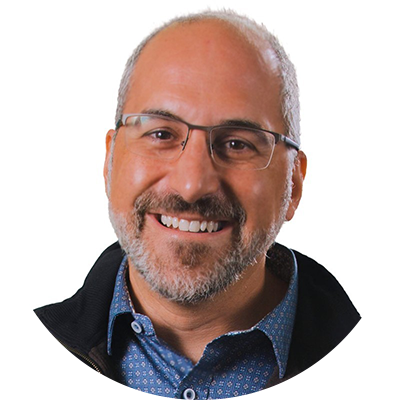marketing
rapport
Episode 4 –
Using Value Exchange to Form Lasting Relationships With Customers with Mike Scafidi of Digitas
RESOURCES ❯ The Marketing Rapport Podcast
Episode Summary
In the past few years, technology has changed the way we communicate and conduct business, the way we shop, and how we live and work. And today, a business that doesn’t involve technology like video conferencing and various applications for project management is unthinkable.
But choosing the right technology is not easy and depends on several factors. Moreover, the tech umbrella covers an ever-increasing selection of products, hence every company must figure out the apt solution for its organizational needs.
Marketing agencies like Digitas, and their CTOs, help companies/clients choose the right technology solution and integrate it into their ecosystem.
In this episode of The Marketing Rapport, our host Cory Davis welcomes Mike Scafidi, the former CTO of Digitas. Mike gets into the importance of continuous value exchange and explains how he advises clients regarding new technology choices. Mike and Cory discuss the relationship between a CMO and a CTO and how to keep up with the overabundance of technologies on the landscape.
Guest-at-a-Glance

- Name: Mike Scafidi
- What he does: Mike is the former CTO of Digitas
- Noteworthy: Mike majored in biology and geology. He entered the tech world and has grown alongside the industry for the past twenty years. Mike joined Digitas in May 2021 after more than nine years on the client side. He has worked at Pepsi, overseeing MarTech, AdTech, and consumer data, among other things. Before that, he spent 12-plus years at Razorfish.
- Where to find Mike: LinkedIn
Key Insights
- There should be no tension between the CMO and the CTO. The CMO is generally in charge of everything related to marketing — from advertising to social media and newsletters — while the CTO typically oversees all aspects of the organization’s technology, both internally and externally. That is why the CMO and the CTO must cooperate so that the company has more efficient and effective marketing. According to Mike, the CMO, CTO, legal counsel, and governance must come together. “Where this is coming up mostly for us is around the changing privacy laws. And as those privacy laws are changing, the data signals are changing for our brands and their ability to target and retarget their customers. So it’s really forcing the conversation around first-party data. And so, along with that, comes the conversation between the CMOs and the CTOs of organizations. And so, at least, the conversations are starting in a way that they haven’t before because of the legislation changes.”
- Continuous exchange of value is very important for the consumer. Consumer packaged goods (CPG) are items that are used daily by average consumers and require routine replacement or replenishment. The CPG market is highly competitive, and consumers switch from one CPG brand to another based on price, availability, brand value, and many other factors. As Mike points out, a company must have a CRM (customer relationship management) database, which contains all the client information collected, governed, transformed, and shared across an organization. “What’s happening now is that a lot of the companies that would have a little more shallow relationship with their customers are at least trying to sustain those relationships, versus ones where it’s more natural, like a bank. You’re going to have a relationship with a bank because it’s a long-term relationship. So I think that’s the shift — recognizing the value of that relationship and putting more focus towards extending a long-term relationship, no matter what the vertical.”
- It is important how clients approach new technologies. A CTO is an executive responsible for managing an organization’s research and development (R&D) and its technological needs. Still, he is also responsible for overseeing the development and dissemination of technology for external customers, vendors, and other clients to help improve and increase business. Mike notes that it is more important how clients approach new things, not what they approach. He also explains how he advises clients on what to pay attention to when it comes to new technologies. “I look at things that are sort of on the horizon in three buckets. And so in the three buckets are: Are we doing it for equity purposes because we want to be relevant? Are we doing it because we want to learn what this means for your vertical and your brand? Or are we doing this because, actually, for you, it’s new, but for your vertical, it’s mature, and you need to sort of catch up? And for that last bucket, I always say, like, augmented reality.”
Episode Highlights
The Importance of Value Exchange
“For a company like PepsiCo, you can have a continued exchange of value because often those promotions are about aligning and supporting people’s lifestyles, be it a music lifestyle or skateboarding lifestyle or whatever that is. With these big brands, the value exchange is around the lifestyle exchange versus if you are with like Peloton, where it’s more of a utility; it’s a more natural relationship. So I think that’s what different verticals need to identify: Where is that value exchange? Why and how can we have an ongoing relationship? What is the reason why it’s not just a one-off?”
How Does a CTO Help Clients Adopt Technologies?
“The first part is looking at the 9,000 technologies on the landscape and saying, ‘How do we even approach this? Why do all these technologies exist? How do we sort of separate the signal from the noise? What’s really important? Do we simplify for our clients, really simplify the conversations and go with either the leaders in the space that have sort of marketing cloud solutions, that have multiple solutions? Or are you looking for best-in-class point solutions?’ That is the conversation, based on culture, with the clients, and that’s where the technology role comes in. […]
My team is strategy, operations, and engineering. And those three are critical in order to say, ‘What do we need? What are the business requirements? How does it translate to a technical solution? How do you build it out for the technologists, engineers, data engineers, frontend engineers, and backend engineers? And then, how do you operate it? How do you get the most out of those investments?’ So, often we’re looking at the culture of the client — are they already working with a cloud solution — a marketing cloud solution — and is there less friction to continue with that cloud solution, or is there a reason why we’d want to go for the point solution and then try to integrate that into the broader ecosystem?”
Keeping Up With Other Technology Companies and What They’re Doing
“First of all, we have to thank Scott Brinker for having six categories, and I think 46 subcategories. That alone helps us say, ‘What is the role of technology, and what’s the job to be done?’ That’s always the starting point, like getting away from technology for technology’s sake, getting away from keeping up with the Joneses — whoever else has this technology, we need it too. We start at, like, what’s the business problem? What is the purpose of the technology? And not only what’s the purpose of technology, but can you continually determine if its meeting its KPIs and get rid of it? With 9,000 out there, our goal is to simplify for the clients. Like, complexity is cost. So, how do we try to reduce complexity to make sure we’re purpose-built for specific business needs? So, when I look at the 9,000, I look at it also through the lens of paid and owned media. If you look at it, about 20% of it is in the paid media space, and 80% of it is in the owned media space. Now, 20% of it is going after a $2.2 trillion industry, and 80% is going after a $500 billion industry. So the complexity is actually on the part of the industry that has the lower revenue opportunity. So that simplifies things as well.”
Top Quotes
[08:41] “The reason for a consumer to maintain a relationship is a continued exchange of value.”
[10:47] “The technology role is helping align and understand what technologies you have in place [as well as] what capabilities you have to implement, maintain, and drive adoption for those technologies.”
[15:38] “As long as there’s value exchange back to the customer, the customers will sort of celebrate that, and it’ll be maintained.”
[15:48] “Contextual or model-driven advertising is an area that’s going to proliferate to sort of compensate for the lack of the easy stuff that we’ve been doing for the last 20 years.”
The views, thoughts, and opinions expressed are those of the speaker and do not necessarily represent the views, thoughts, and opinions of Verisk Marketing Solutions or Verisk Analytics. The material and information presented here is for general information purposes only.
This podcast is not intended to replace legal or other professional advice. The Lead Intelligence, Inc. (dba Verisk Marketing Solutions) and Verisk Analytics LLC names and all forms and abbreviations are the property of its owner and its use does not imply endorsement of or opposition to any specific organization, product, or service.
VERISK MARKETING SOLUTIONS DISCLAIMS ALL LIABILITY ARISING OUT OF ANY INDIVIDUAL'S USE OF, REFERENCE TO, RELIANCE ON, OR INABILITY TO USE THIS PODCAST OR THE INFORMATION PRESENTED IN THIS PODCAST.



 Your Privacy Choices for Platform Services | Data Services
Your Privacy Choices for Platform Services | Data Services